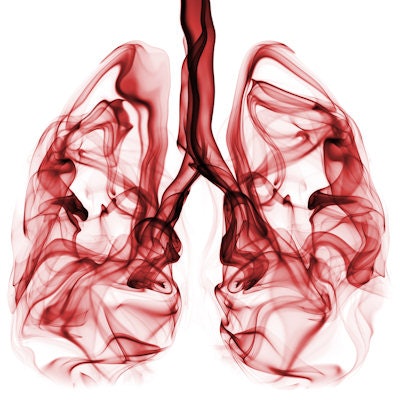
Despite research suggesting that screening for lung cancer with low-dose CT can reduce mortality by 20%, many patients at risk of the disease are not undergoing screening, according to a commentary published April 9 in the Oncologist.
Why this is the case isn't certain, wrote Dr. Humberto Choi and Dr. Nathan Pennell, PhD, both of the Cleveland Clinic.
"Despite the ample evidence of benefit, lung cancer screening adoption remains low," the team wrote. "It is estimated that approximately 3.9% of 6.8 million eligible smokers were screened in 2015, according to the National Health Interview Survey. The reasons are not all clear, but it is likely correct to assume that lack of resources, geographic isolation, and uninsured status certainly contribute to this disparity."
Yet in addition to patient demographic factors, part of the low screening uptake may be attributable to clinicians, Choi and Pennell noted. Identifying benign lung nodules on CT -- and then managing them -- can be tricky.
"[A] concern that may be limiting enthusiasm and uptake of low-dose CT screening is the management of benign lung nodules, which are found at high rates on screening CT scans," the authors noted. "In the NLST [National Lung Screening Trial], overall, 24% of screened patients had a positive finding, but 96.4% of those nodules were determined to be false positives. Careful evaluation and follow-up is needed to avoid both missing true early lung cancers and [avoiding] potentially morbid interventions on benign modules."
And then there's the fact that suspicious nodules often turn out to be benign: Data from the Pulmonary Nodule and Lung Cancer Screening Clinic at Massachusetts General Hospital in Boston showed that 42.7% of patients who underwent biopsy and 17% of those who underwent surgery for suspicious nodules had no cancer, the authors noted.
So how can lung cancer screening uptake be increased? Choi and Pennell suggested two ideas:
- Support clinicians by reviewing all positive findings on screening CT at a dedicated tumor board.
- Support patients by establishing mobile screening programs to reach those who are uninsured, minority, and rural.
But these suggestions won't completely address the problem of low CT lung screening compliance, they cautioned. More education is needed.
"Although an itinerant program helps to overcome some barriers to lung cancer screening in specific locations and populations, and multidisciplinary management of nodules may aid in managing patients with positive findings and reduce unnecessary procedures, we need to continue to study the reasons why uptake is so low nationwide," the authors concluded. "Efforts to improve awareness of the benefits of lung cancer screening and access to screening programs, as well as efforts to minimize potential harms, will expand the impact of this important public health intervention."





















